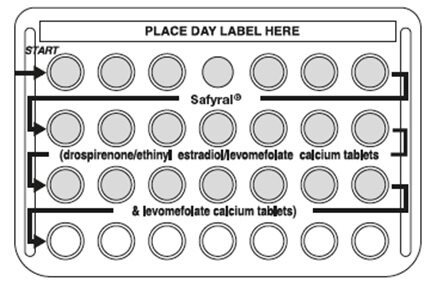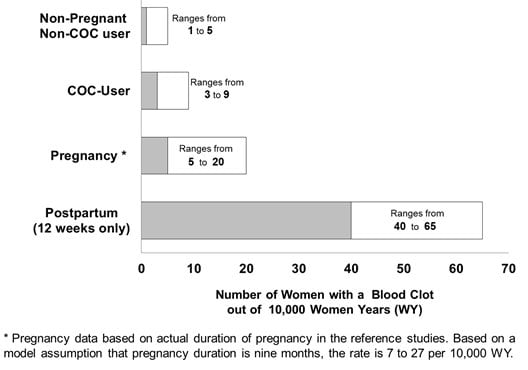Safyral is a birth control pill. It contains two female hormones, a synthetic estrogen called ethinyl estradiol and a progestin called drospirenone. Safyral also contains levomefolate calcium, which is a B vitamin.
The progestin drospirenone may increase potassium. Therefore, you should not take Safyral if you have kidney, liver or adrenal disease because this could cause serious heart and health problems. Other drugs may also increase potassium. If you are currently on daily, long-term treatment for a chronic condition with any of the medications below, you should consult your healthcare provider about whether Safyral is right for you, and during the first month that you take Safyral, you should have a blood test to check your potassium level.
- NSAIDs (ibuprofen [Motrin, Advil], naproxen [Aleve and others] when taken long-term and daily for treatment of arthritis or other problems)
- Potassium-sparing diuretics (spironolactone and others)
- Potassium supplementation
- ACE inhibitors (Capoten, Vasotec, Zestril and others)
- Angiotensin-II receptor antagonists (Cozaar, Diovan, Avapro and others)
- Heparin
- Aldosterone antagonists
Safyral may also be taken by women who elect to use an oral contraceptive, to provide folate supplementation. It is recommended that women of reproductive age supplement their diet with 0.4 mg (400 mcg) of folic acid daily to lower their risk of having a pregnancy with a rare type of birth defect (known as a neural tube defect). The amount of folate contained in Safyral supplements folate in the diet to lower this risk should you become pregnant while taking the drug or shortly after stopping it.
How Well Does Safyral Work?
Your chance of getting pregnant depends on how well you follow the directions for taking your birth control pills. The better you follow the directions, the less chance you have of getting pregnant.
Based on the results of two clinical studies, about1 woman out of 100 women, may get pregnant during the first year they use Safyral.
The following chart shows the chance of getting pregnant for women who use different methods of birth control. Each box on the chart contains a list of birth control methods that are similar in effectiveness. The most effective methods are at the top of the chart. The box on the bottom of the chart shows the chance of getting pregnant for women who do not use birth control and are trying to get pregnant.
Who should not take Safyral?
Your healthcare provider will not give you Safyral if you:
- Ever had blood clots in your legs (deep vein thrombosis), lungs (pulmonary embolism), or eyes (retinal thrombosis)
- Ever had a stroke
- Ever had a heart attack
- Have certain heart valve problems or heart rhythm abnormalities that can cause blood clots to form in the heart
- Have an inherited problem with your blood that makes it clot more than normal
- Have high blood pressure that medicine can’t control
- Have diabetes with kidney, eye, nerve, or blood vessel damage
- Ever had certain kinds of severe migraine headaches with aura, numbness, weakness or changes in vision
- Ever had breast cancer or any cancer that is sensitive to female hormones
- Have liver disease, including liver tumors
- Have kidney disease
- Have adrenal disease
Also, do not take birth control pills if you:
- Smoke and are over 35 years old
- Are or suspect you are pregnant
Birth control pills may not be a good choice for you if you have ever had jaundice (yellowing of the skin or eyes) caused by pregnancy (also called cholestasis of pregnancy).
Tell your healthcare provider if you have ever had any of the above conditions (your healthcare provider can recommend another method of birth control).
Tell your healthcare provider if you are already taking daily folate supplements.
What should I tell my healthcare provider before taking Safyral?
Tell your healthcare provider about all the medicines you take, including prescription and over-the-counter medicines, vitamins and herbal supplements.
Safyral may affect the way other medicines work, and other medicines may affect how well Safyral works. Know the medicines you take.
Keep a list of them to show your healthcare provider and pharmacist when you get a new medicine.
How should I take Safyral?
1. Be sure to read these directions before you start taking your pills or anytime you are not sure what to do.
2. The right way to take the pill is to take one pill every day at the same time in the order directed on the package. Preferably, take the pill after the evening meal or at bedtime, with some liquid, as needed. Safyral can be taken without regard to meals.
If you miss pills you could get pregnant. This includes starting the pack late. The more pills you miss, the more likely you are to get pregnant. See "What To Do If You Miss Pills” below.
3. Many women have spotting or light bleeding at unexpected times, or may feel sick to their stomach during the first 1-3 packs of pills.
If you do have spotting or light bleeding or feel sick to your stomach, do not stop taking the pill. The problem will usually go away. If it does not go away, check with your healthcare provider.
4. Missing pills can also cause spotting or light bleeding, even when you make up these missed pills.
On the days you take two pills, to make up for missed pills, you could also feel a little sick to your stomach.
5. If you have vomiting (within 3 to 4 hours after you take your pill), you should follow the instructions for "What To Do If You Miss Pills" If you have diarrhea or if you take certain medicines, including some antibiotics and some herbal products such as St. John's Wort, your pills may not work as well.
Use a back-up method (such as condoms and spermicides) until you check with your healthcare provider.
6. If you have trouble remembering to take the pill, talk to your healthcare provider about how to make pill-taking easier or about using another method of birth control.
7. If you have any questions or are unsure about the information in this leaflet, call your healthcare provider.
Before You Start Taking Your Pills
1. Decide What Time of Day You Want to Take Your Pill
It is important to take Safyral in the order directed on the package at the same time every day, preferably after the evening meal or at bedtime, with some liquid, as needed. Safyral can be taken without regard to meals.
2. Look at Your Pill Pack – It has 28 Pills
The Safyral pill pack has 21 orange pills (with hormones and folate) to be taken for three weeks, followed by 7 light orange pills (without hormones, containing folate) to be taken for one week. It is important to take the light orange pills because they contain folate.
3. Also look for:
a) Where on the pack to start taking pills,
b) In what order to take the pills (follow the arrows)

4. Be sure you have ready at all times (a) another kind of birth control (such as condoms and spermicides) to use as a back-up in case you miss pills, and (b) an extra, full pill pack.
When To Start the First Pack of Pills
You have a choice for which day to start taking your first pack of pills. Decide with your healthcare provider which is the best day for you. Pick a time of day which will be easy to remember.
Day 1 Start:
1. Take the first orange pill of the pack during the first 24 hours of your period.
2. You will not need to use a back-up method of birth control, because you are starting the Pill at the beginning of your period. However, if you start Safyral later than the first day of your period, you should use another method of birth control (such as a condom and spermicide) as a back-up method until you have taken 7 orange pills.
Sunday Start:
1. Take the first orange pill of the pack on the Sunday after your period starts, even if you are still bleeding. If your period begins on Sunday, start the pack that same day.
2. Use another method of birth control (such as a condom and spermicide) as a back-up method if you have sex anytime from the Sunday you start your first pack until the next Sunday (7 days). This also applies if you start Safyral after having been pregnant and you have not had a period since your pregnancy.
When You Switch From a Different Birth Control Pill
When switching from another birth control pill, Safyral should be started on the same day that a new pack of the previous birth control pill would have been started.
When You Switch From Another Type of Birth Control Method
When switching from a transdermal patch or vaginal ring, Safyral should be started when the next application would have been due. When switching from an injection, Safyral should be started when the next dose would have been due. When switching from an intrauterine contraceptive or an implant, Safyral should be started on the day of removal.
What to Do During the Month
1. Take one pill at the same time every day until the pack is empty.
Do not skip pills even if you are spotting or bleeding between monthly periods or feel sick to your stomach (nausea).
Do not skip pills even if you do not have sex very often.
2. When you finish a pack of pills, start the next pack on the day after your last light orange pill. It is important to take the light orange pills because they contain folate. Do not wait any days between packs.
If you miss 1 orange pill in Week 1 of your pack:
1. Take it as soon as you remember. Take the next pill at your regular time. This means you may take two pills in one day.
2. You do not need to use a back-up birth control method if you have sex.
If you miss 2 orange pills in a row in Week 1 or Week 2 of your pack:
1. Take two pills on the day you remember and two pills the next day.
2. Then take one pill a day until you finish the pack.
3. You could become pregnant if you have sex in the 7 days after you restart your pills. You must use another birth control method (such as a condom and spermicide) as a back-up for those 7 days.
If you miss 2 orange pills in a row in Week 3 or Week 4 of your pack:
1. If you are a Day 1 Starter:
Throw out the rest of the pill pack and start a new pack that same day.
2. If you are a Sunday Starter:
Keep taking one pill every day until Sunday. On Sunday, throw out the rest of the pack and start a new pack of pills that same day.
3. You could become pregnant if you have sex in the 7 days after you restart your pills. You must use another birth control method (such as a condom and spermicide) as a back-up for those 7 days.
4. You may not have your period this month but this is expected. However, if you miss your period two months in a row, call your healthcare provider because you might be pregnant.
If you miss 3 or more orange pills in a row during any week:
1. If you are a Day 1 Starter:
Throw out the rest of the pill pack and start a new pack that same day.
2. If you are a Sunday Starter:
Keep taking 1 pill every day until Sunday. On Sunday, throw out the rest of the pack and start a new pack of pills that same day.
3. You could become pregnant if you have sex in the 7 days after you restart your pills. You must use another birth control method (such as condoms and spermicides) as a back-up for those 7 days.
4. You may not have your period this month but this is expected. However, if you miss your period two months in a row, call your healthcare provider because you might be pregnant.
If you miss any of the 7 light orange pills in Week 4:
Throw away the pills you missed.
Keep taking one pill each day until the pack is empty.
You do not need a back-up method.
Finally, if you are still not sure what to do about the pills you have missed:
Use a back-up method (such as condoms and spermicides) anytime you have sex.
Contact your healthcare provider and continue taking one active orange pill each day until otherwise directed.
What Else Should I know about Taking Safyral?
Birth control pills do not protect you against any sexually transmitted disease, including HIV, the virus that causes AIDS.
Do not skip any pills, even if you do not have sex often.
If you miss a period, you could be pregnant. However, some women miss periods or have light periods on birth control pills, even when they are not pregnant. Contact your healthcare provider for advice if you:
- Think you are pregnant
- Miss one period and have not taken your birth control pills on time every day
- Miss two periods in a row
Birth control pills should not be taken during pregnancy. However, birth control pills taken by accident during pregnancy are not known to cause birth defects.
Due to an increased risk of blood clots, you should stop Safyral at least four weeks before you have major surgery and not restart it until at least two weeks after the surgery.
If you are breastfeeding, consider another birth control method until you are ready to stop breastfeeding. Birth control pills that contain estrogen, like Safyral, may decrease the amount of milk you make. A small amount of the pill's hormones pass into breast milk.
Folates may make certain drugs, including some used for epilepsy, less effective, so talk to your healthcare provider about any medicines you take.
If you have vomiting or diarrhea, your birth control pills may not work as well. Take another pill if you vomit within 3-4 hours after taking your pill, or use another birth control method, like condoms and a spermicide, until you check with your healthcare provider.
If you are scheduled for any laboratory tests, tell your doctor you are taking birth-control pills. Certain blood tests may be affected by birth-control pills.
What are the possible side effects of Safyral?
Like pregnancy, birth control pills increase the risk of serious blood clots (see following graph), especially in women who have other risk factors, such as smoking, obesity, or age greater than 35. This increased risk is highest when you first start taking birth control pills and when you restart the same or different birth control pills after not using them for a month or more. Women who use birth control pills with drospirenone (like Safyral) may have a higher risk of getting a blood clot. Some studies reported that the risk of blood clots was higher for women who use birth control pills that contain drospirenone than for women who use birth control pills that do not contain drospirenone.
Talk with your healthcare provider about your risk of getting a blood clot before deciding which birth control pill is right for you.
It is possible to die or be permanently disabled from a problem caused by a blood clot, such as a heart attack or a stroke. Some examples of serious clots are blood clots in the:
- Legs (deep vein thrombosis or DVT)
- Lungs (pulmonary embolus or PE)
- Eyes (loss of eyesight)
- Heart (heart attack)
- Brain (stroke)
To put the risk of developing a blood clot into perspective: If 10,000 women who are not pregnant and do not use birth control pills are followed for one year, between 1 and 5 of these women will develop a blood clot. The figure below shows the likelihood of developing a serious blood clot for women who are not pregnant and do not use birth control pills, for women who use birth control pills, for pregnant women, and for women in the first 12 weeks after delivering a baby.
Likelihood of Developing a Serious Blood Clot

A few women who take birth control pills may get:
- High blood pressure
- Gallbladder problems
- Rare cancerous or noncancerous liver tumors
All of these events are uncommon in healthy women.
Call your healthcare provider right away if you have:
- Persistent leg pain
- Sudden shortness of breath
- Sudden blindness, partial or complete
- Severe pain in your chest
- Sudden, severe headache unlike your usual headaches
- Weakness or numbness in an arm or leg, or trouble speaking
- Yellowing of the skin or eyeballs
The most common side effects of birth control pills are:
- Spotting or bleeding between menstrual periods
- Nausea
- Breast tenderness
- Headache
These side effects are usually mild and usually disappear with time.
Less common side effects are:
- Acne
- Less sexual desire
- Bloating or fluid retention
- Blotchy darkening of the skin, especially on the face
- High blood sugar, especially in women who already have diabetes
- High fat (cholesterol; triglyceride) levels in the blood
- Depression, especially if you have had depression in the past. Call your healthcare provider immediately if you have any thoughts of harming yourself.
- Problems tolerating contact lenses
- Weight changes
This is not a complete list of possible side effects. Talk to your healthcare provider if you develop any side effects that concern you. You may report side effects to the FDA at 1-800-FDA-1088.
No serious problems have been reported from a birth control pill overdose, even when accidentally taken by children.
Do Birth Control Pills Cause Cancer?
Birth control pills do not seem to cause breast cancer. However, if you have breast cancer now, or have had it in the past, do not use birth control pills because some breast cancers are sensitive to hormones.
Women who use birth control pills may have a slightly higher chance of getting cervical cancer. However, this may be due to other reasons such as having more sexual partners.
What Should I Know about My Period when Taking Safyral?
Irregular vaginal bleeding or spotting may occur while you are taking Safyral. Irregular bleeding may vary from slight staining between menstrual periods to breakthrough bleeding, which is a flow much like a regular period. Irregular bleeding occurs most often during the first few months of oral contraceptive use, but may also occur after you have been taking the pill for some time. Such bleeding may be temporary and usually does not indicate any serious problems. It is important to continue taking your pills on schedule. If the bleeding occurs in more than one cycle, is unusually heavy, or lasts for more than a few days, call your healthcare provider.
Some women may not have a menstrual period but this should not be cause for alarm as long as you have taken the pills regularly on time.
What if I Miss My Scheduled Period when Taking Safyral?
It is not uncommon to miss your period. However, if you miss two periods in a row or miss one period when you have not taken your birth control pills regularly on time, call your healthcare provider. Also notify your healthcare provider if you have symptoms of pregnancy such as morning sickness or unusual breast tenderness. It is important that your healthcare provider checks you to find out if you are pregnant. Stop taking Safyral if you are pregnant.
What If I Want to Become Pregnant?
You may stop taking the pill whenever you wish. Consider a visit with your healthcare provider for a pre-pregnancy checkup before you stop taking the pill. See your healthcare provider about appropriate folate supplementation if you stop taking Safyral, are pregnant, or plan on becoming pregnant.
Safyral Images
General information about the safe and effective use of Safyral
Your healthcare provider prescribed Safyral for you. Please do not share Safyral with anyone else. Keep Safyral out of the reach of children.
If you have concerns or questions, ask your healthcare provider. You may also ask your healthcare provider for a more detailed label written for medical professionals.
What are the ingredients in Safyral?
Orange tablets
Active ingredients: drospirenone, ethinyl estradiol and levomefolic acid
Inactive ingredients: ferric oxide yellow, unspecified hypromellose, lactose monohydrate, magnesium stearate, titanium dioxide, betadex, microcrystalline cellulose, croscarmellose sodium, unspecified polyethylene glycol, talc, ferric oxide red
Light orange tablets
Active ingredients: levomefolate calcium
Inactive ingredients: unspecified hypromellose, lactose monohydrate, magnesium stearate, talc, titanium dioxide, microcrystalline cellulose, croscarmellose sodium, hydroxypropyl cellylose (1600000WAMW), unspecified polyethylene glycol, ferric oxide red, ferric oxide yellow.



